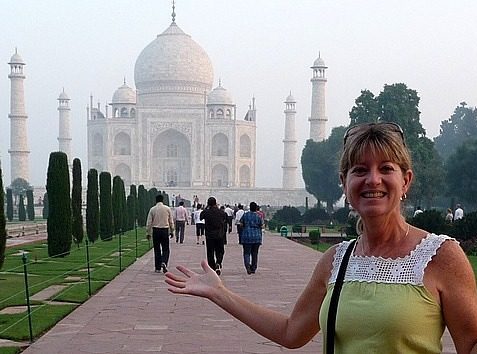And so my fabulous sabbatical has come to an end. I had a few hours on Friday before I had to catch my 9:00 p.m. flight to Dallas with a connection to Seattle so my guide for the first two days, the fabulous Jessica, and I were going to take a cab to La Boca. Now most people who have been to Buenos Aires hear the name La Boca, a neighborhood in the southeast portion of Buenos Aries and think of two things: Boca Juniors, the famous soccer team and La Boca the rough and sometimes dangerous barrio. I was going to see La Boca, the tourist area (yep La Boca has a tourist area).

Now La Boca, which means “the mouth” in Spanish, is so named because the barrio sits at the mouth of the Mantanza River. La Boca is believed to be the earliest settlement in Buenos Aires with the Spanish having first landed at “the mouth” in 1536.
The La Boca area saw a mass influx of migration from Western European countries in the mid 19th century, with many of the immigrants coming from Italy. The newcomers built homes made of scrap metal and painted the shanties bright colours to liven up the buildings. The area would soon give birth to the Tango (although people from San Telmo claim the Tango was created in San Telmo not La Boca). The working class would meet in in bars and halls to dance and win the affection of the few women in the area.

As people in La Boca gained affluence in the late 19th century, they tended to move up town away from La Boca resulting in the decline of area. However, the real downfall for the barrio came when the port was moved from La Boca to Puerto Madero and with it all of the jobs.
Nevertheless, La Boca experienced a bit of a renaissance in the 1950s when La Boca orphan and famed artist, Don Benito Quinquela Martin decided to save the barrio by inspiring La Boca residents to paint their homes and businesses in bright colours. Today, La Boca remains a working class neighborhood that is famous for its brightly painted buildings, La Boca Juniors soccer team, and the tango and, perhaps, infamous for its rough and tumble and sometimes, unsafe streets.

So Jessica and I took a cab to La Boca at 9:30, which unfortunately is the height of Buenos Aires rush hour. However, lucky for me, as it forced the cab driver off the main arteries and onto the backstreets. This gave me an off the beaten path view of Buenos Aires and its little neighborhoods that are seldom seen by tourists. After almost 45 minutes, we reached La Boca just after 10:30 a.m. and immediately set off for El Caminito, the cobblestone pedestrian street that is the heart of La Boca’s tourist area.
Now as we walked Jessica was a wealth of information about La Boca, providing me with the history I described above as well as telling me that the pedestrian street was named El Caminito after a 1926 tango song.

We soon reached El Caminito Street, and when we arrived, vendors were in the process of setting up stalls to sell their art and wares, and faux tango dancers were trying to entice tourists to have their picture taken in tango attire for the sum of $5 USD. And not surprisingly, their were some gullible tourists willing to fork over the money.
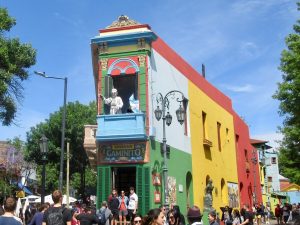

We wandered down El Caminito dodging dozens of school children, (it is the end of the school year here so kids are on field trips wherever you go), to take in the gorgeous multi-coloured buildings. In addition to the beautiful buildings, we saw amazing paintings on the walls and the ever present paper mache figurines of some of Buenos Aires (and La Boca’s most famous people). In fact, at the beginning of El Caminito, the balcony now features a large figure of the Pope. Apparently Maradona, La Boca’s most famous and favourite football hero, used to occupy this prestigious location, but when the Pope was elected, Maradona was moved to a balcony around the corner.

And just as I was hearing about the Pope story, the balcony now housing Maradona, as well as Evita Peron and Carlos Gardel came into view. I could not get enough of these crazy paper mache caricatures of Buenos Aires’ favoured sons and daughters.
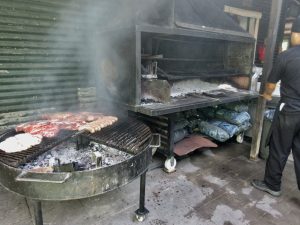
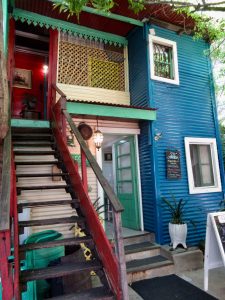
Anyway, we continued to wander around and as we turned the corner and went up another side street we left the tourists behind and were soon walking past brightly coloured buildings on our own. And about half way down the street we found the lovely little El Gran Paraiso, a barbeque restaurant that was in full cooking mode for the afternoon lunch hour. Jessica knows the owner so we were invited in to take a look at the restaurant and the amazing views the upper portion of the restaurant offers of the neighborhood.


Now the best part about the little tour of the restaurant, besides the fantastic aroma, was the view into the lives of the real La Boca residents. I could see someone’s laundry hanging out to dry (and they were clearly soccer aka football fans) and I could see lovely colourful terraces and courtyards all hidden from the view of tourists on the street. It was simply gorgeous and a very different perspective from the headline grabbing negative news from La Boca.
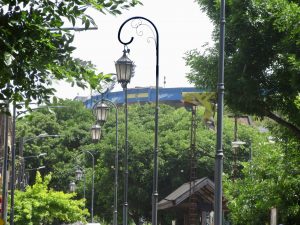
We eventually left the restaurant and walked around the corner where I caught a glimpse of the world famous La Bombonera, the home of the Boca Juniors. Now, unfortunately, I was not able to see the entire stadium, but certainly caught a good view of the upper levels of the stadium which was better than nothing.

We then crossed the street and ran headlong into a number of Tango dancers. Now many of these tango dancers are shilling for restaurants to entice you to come in and eat, while others are plying their trade hoping to become better so they can be featured in Tango shows around Buenos Aires. We stopped for a bit to enjoy the music and dancers before we continued on.

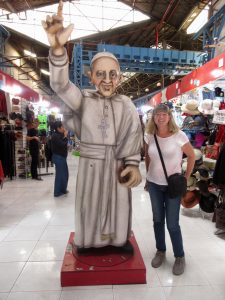
We then made a couple stops in shops so that I could buy a La Boca shirt (hey when in Rome) and see some of the hidden music areas, including a little stage where a young man was playing a concertina, an accordion like instrument that is used in Tango shows.
We continued our walk to the La Boca waterfront and its former port. At this point, we said goodbye to La Boca and caught a bus to take us up town to Recoleta, my final stop on my tour of Buenos Aires. Now I had been to Recoleta on Sunday to see the cemetery, but we had not walked the streets to see the old upscale homes in the neighborhood.
So the bus took us straight through the heart of Buenos Aires past the train station dropping us off a couple blocks from Recoleta. Jessica and I then began our walk as the clouds rolled in and the wind picked up. Fortunately, the little respite from the sun was short lived as we were soon back in sunshine.
Now the Recoleta area is most famous for the cemetery. However, Recoleta is also know if is lavish old homes and palaces, lovely streets and upscale boutiques and shops. So as we wandered through the beautiful streets, Jessica pointed out notable homes.

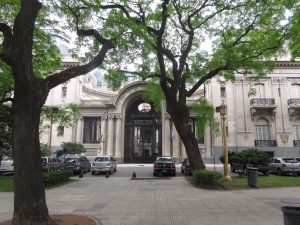
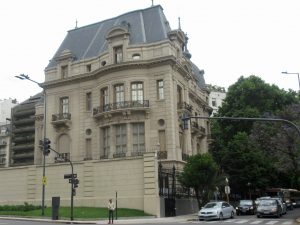




First up was the Paz family home, which was more like a palace. The Paz family owned La Prensa (the newspaper) and also own a sizable mausoleum in the Recoleta cemetery. We then saw the Palacio San Martin, now home to the Argentina Defense Department (quite the digs), and just down the road from that was the French and Brazilian embassies all housed in former mansions. We also saw a gorgeous old family home that had been purchased by the Four Seasons and is now Buenos Aires’ only six star hotel. Then it was on to a row of old mansions, including the Pacino Duhau, which now houses an upscale Hyatt and next doors was an old mansion that now houses the Vatican embassy.
We ended our walking tour with a stroll past one of the most historical hotels in Buenos Aires, the Alvear Palace Hotel. Once the grand dame of hotels in Buenos Aires, the hotel is slightly past its prime with new upscale boutique hotels moving into the area. Nevertheless, if you like old historic buildings, the Alvear still fits the bill.
And with that, my tour of Buenos Aires and my sabbatical had come to an end. I said goodbye to the amazing Jessica and went back to my hotel for a quick late lunch before taking a cab to the airport. My sabbatical had been one long glorious vacation. And if you are keeping track at home, here is a running tally of notables on my trip:
1. 3 lost items (tweezers, white linen t-shirt and earring);
2. 4 broken items (camera strap, camera, camera again and sunglasses);
3. 3 incidents of food poisoning: Dingle, Ireland, Dubai and Salta/Buenos Aires airport, 1 spider bite and 1 seriously bruised calf;
4. 1 crappy tour guide (guide for Lake Titicaca island tour);
5. 1 crappy hotel (Guest House Metreveli in Borjomi, Georgia although the accommodations in the Pantanal were pretty rough;
6. no thefts;
7. no lost luggage;
8. too many amazing guides and drivers to count although Liam in Ireland was a massive standout;
9. too many amazing hotels to count although the Lougheske Castle and the Ashford Castle in Ireland, the Hotel Casa do Amareliado in Salvador, the Belmond Hotel in Iguazu Falls, Brazil, the Legado Mitico Hotel in Salta and the Fierro Hotel in Buenos Aires are the clear winners;
10. the glorious wonderful food and wine in every country I visited; and
11. as always, the incredible people I met from all over the world.
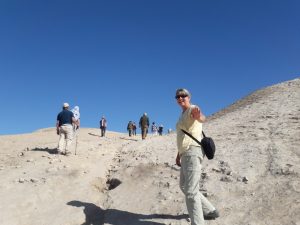
I am sad that my adventure has come to an end, but it only means it is time to plan the next one. Thanks for following along with me. And special thanks to my sister Cheryl and brother-in-law Donnie for meeting me in Ireland and to my friend Tom Linde for sharing my adventures in Brazil and Argentina. I cannot begin to describe what an incredible journey it has been. As they say in Argentina, Chow … until the next time!
